When to Stop Watering Onions Before Harvest UK: Perfect Timing for Storage Success
Discover the crucial timing for stopping onion watering before harvest in the UK. Learn how proper watering schedules affect storage life, bulb quality, and when to cease irrigation for spring and autumn planted varieties in British growing conditions.
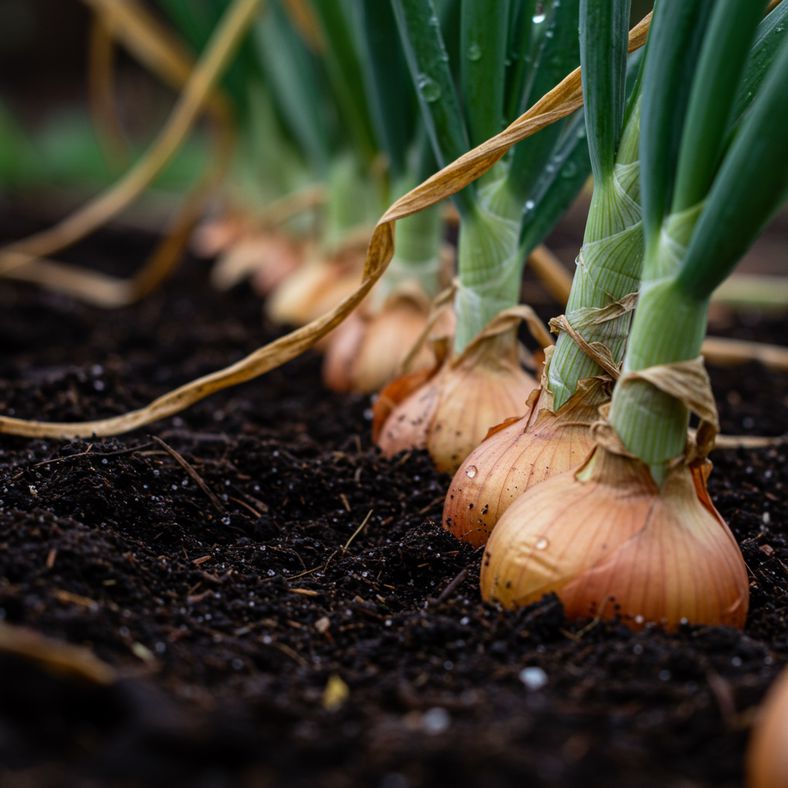
- Understanding Onion Bulb Development and Water Requirements
- When to Stop Watering Spring-Planted Onions (July-September Harvest)
- When to Stop Watering Autumn-Planted Onions (June-July Harvest)
- Reading the Natural Signs: When Your Onions Tell You to Stop
- The Critical Connection: Watering and Storage Success
- Managing UK Weather Challenges During the Critical Period
- Post-Watering Care and Pre-Harvest Preparation
- Variety-Specific Timing Considerations for UK Growers
- Common Mistakes and How to Avoid Them
- Maximising Storage Life Through Proper Timing
Knowing precisely when to stop watering onions before harvest is one of the most critical decisions UK gardeners face for ensuring successful storage and preventing rot. The timing of your final irrigation can make the difference between onions that store beautifully through winter and those that deteriorate within weeks of harvest.
In the UK's unique climate, with our unpredictable summer weather patterns, understanding the relationship between watering, bulb development, and storage success becomes even more crucial. Whether you're growing spring-planted sets for autumn harvest or overwintering varieties for summer lifting, the principles remain the same but the timing varies significantly.
Understanding Onion Bulb Development and Water Requirements

Onions follow a predictable growth pattern that directly influences when you should cease watering. During the initial growth phase, from planting through early summer, onions require consistent moisture to develop their root systems and foliage. The more leaves an onion produces during this critical period, the larger and better quality the final bulb will be.
As day length increases in late spring and early summer, onions receive the trigger to begin bulb formation. This photoperiod response is what transforms the plant's energy from leaf production to bulb swelling. During this bulb development phase, adequate moisture remains essential for achieving good size and preventing stress.
However, as bulbs reach maturity and begin the natural senescence process, continued watering becomes counterproductive. Excess moisture during the final weeks before harvest can lead to:
- Delayed skin formation and curing
- Increased susceptibility to storage rots
- Splitting or cracking of mature bulbs
- Delayed harvest timing
- Poor storage characteristics
The key is recognising when your onions have completed their bulb development phase and are beginning to mature. This transition typically occurs during mid to late summer for spring-planted onions, and early summer for autumn-planted varieties.
When to Stop Watering Spring-Planted Onions (July-September Harvest)
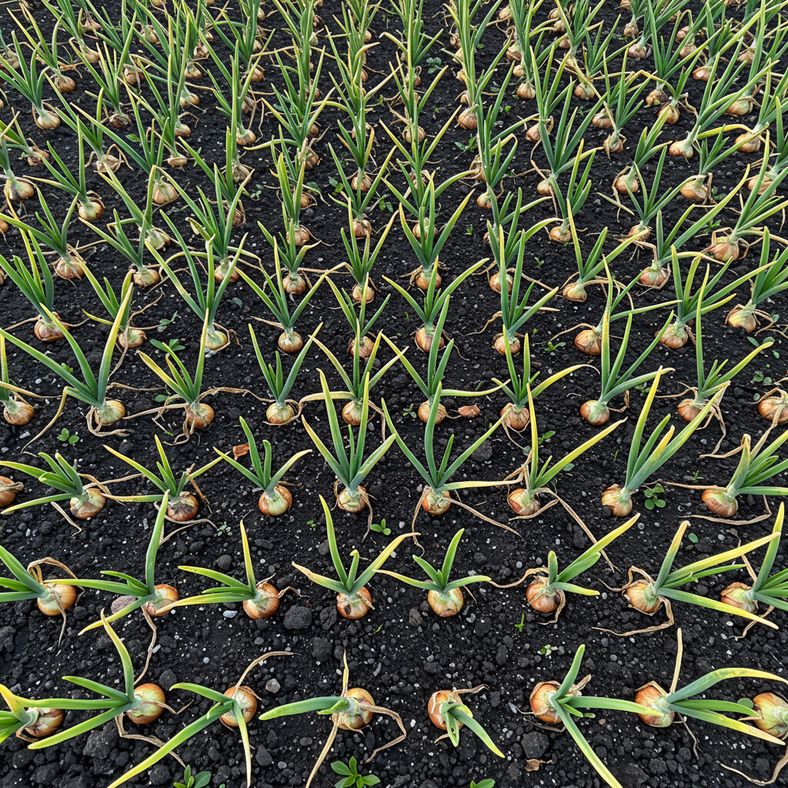
For spring-planted onion sets and seed-raised onions destined for July through September harvest, the critical stopping point for watering typically falls in mid-July to early August, depending on your specific location within the UK and the variety grown.
Key Timing Indicators:
- Foliage Changes: When 50-75% of the green foliage begins showing signs of yellowing or browning, it's time to stop watering. This natural senescence indicates the bulbs are approaching maturity.
- Neck Softening: The area where the leaves meet the bulb (the neck) begins to soften and narrow. This is a clear sign that the plant is redirecting energy from foliage to bulb completion.
- Bulb Sizing: When bulbs have reached their expected mature size for the variety, continued watering won't increase size but may compromise storage quality.
- Calendar Timing: As a general rule, cease watering 3-4 weeks before your intended harvest date. For most UK gardens, this means stopping by mid-July for August harvest, or early August for September harvest.
Regional Variations Across the UK:
Northern regions (Scotland, Northern England) may need to stop watering slightly earlier due to shorter growing seasons and cooler temperatures that slow the curing process. Southern regions can often continue watering a week longer, but should still cease by early August at the latest.
During wet summers, you may need to provide protection from rainfall once you've stopped irrigation. Consider using cloches or temporary covers during heavy downpours to prevent waterlogged soil around maturing bulbs.
When to Stop Watering Autumn-Planted Onions (June-July Harvest)
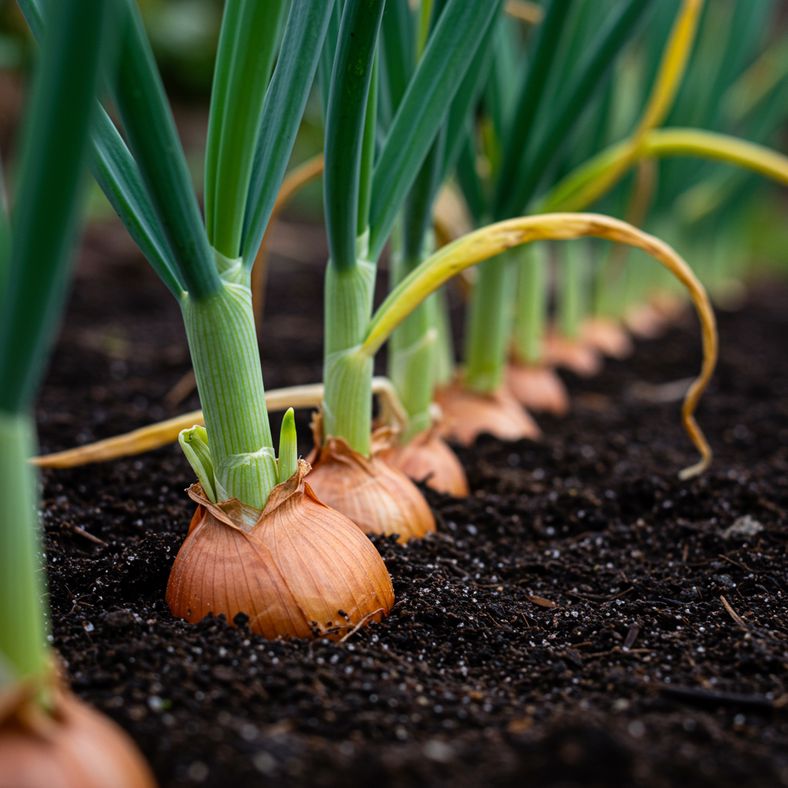
Overwintering or Japanese onion varieties planted in autumn follow a different timeline, with harvest typically occurring in June and July. For these earlier-maturing crops, you'll need to stop watering approximately 3-4 weeks before harvest, which usually means ceasing irrigation in late May to early June.
Specific Timing for Overwintering Varieties:
- Late May: Begin monitoring foliage for yellowing signs. Overwintering onions often show maturity indicators earlier due to their extended growing period.
- Early June: Stop watering when the first signs of neck softening appear and foliage begins to topple naturally.
- Weather Considerations: June can be unpredictably wet in many parts of the UK. If stopping watering coincides with heavy rainfall periods, consider creating drainage channels or raised beds to prevent waterlogging.
Advantages of Autumn-Planted Timing:
Autumn-planted onions benefit from natural weather patterns that often provide ideal curing conditions. The typically drier weather of late June and July in most UK regions creates perfect conditions for skin formation and moisture reduction without the need for artificial protection.
However, in exceptionally wet years, you may need to harvest slightly earlier than optimal to prevent rot, even if this means smaller bulb sizes. It's better to harvest slightly immature onions that will store moderately well than to lose the entire crop to wet rot.
Reading the Natural Signs: When Your Onions Tell You to Stop
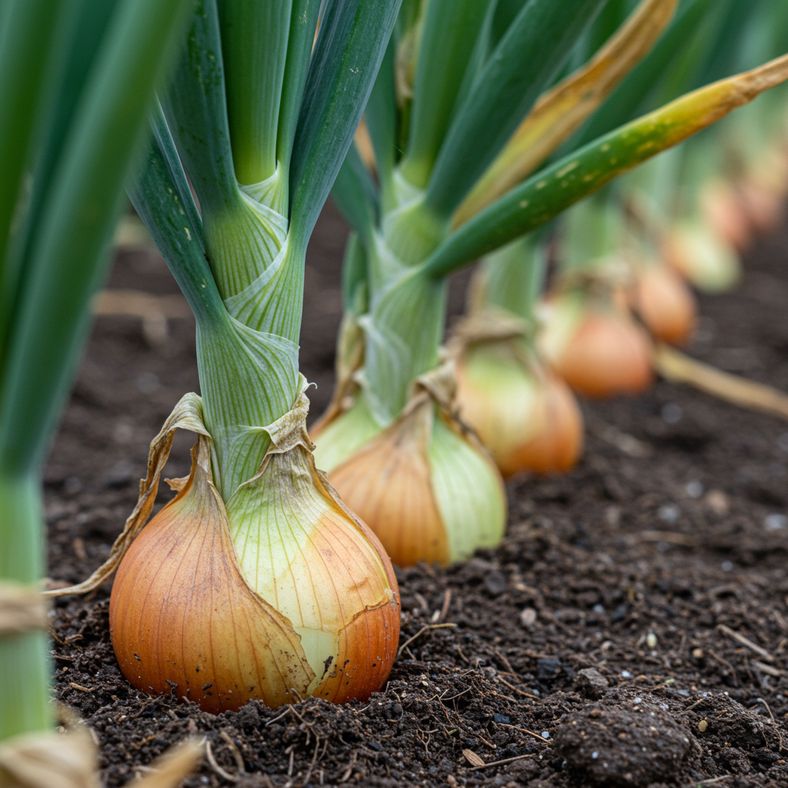
Experienced UK gardeners learn to read their onions' natural signals rather than relying solely on calendar dates. These biological indicators provide more reliable guidance than fixed schedules, especially given the UK's variable weather patterns.
Primary Visual Indicators:
- Foliage Yellowing: Starting from the tips and progressing downward, healthy yellowing indicates natural senescence. This differs from disease-related yellowing, which typically shows spots or patches.
- Toppling Foliage: When 50% or more of the foliage begins falling over naturally, this signals that the connection between leaves and bulb is weakening—a clear sign to stop watering.
- Neck Appearance: The neck area becomes noticeably thinner and softer. You should be able to feel this change when gently pressing the area where leaves meet the bulb.
- Skin Development: Mature bulbs develop papery, dry outer skins that rustle when touched. This protective layer is crucial for storage success.
What NOT to Do:
Avoid the old practice of bending over healthy green foliage or deliberately breaking roots to force maturity. Modern growing wisdom recognises that allowing natural senescence produces better storage results. Similarly, don't continue watering in hopes of increasing bulb size once maturity signs appear—this only compromises storage quality.
Dealing with Uneven Maturity:
In many UK gardens, onions won't all mature simultaneously. Stop watering when 60-70% of your crop shows maturity signs. The remaining onions will typically follow within 7-10 days, and any that remain stubbornly green can be harvested as fresh onions for immediate use.
The Critical Connection: Watering and Storage Success
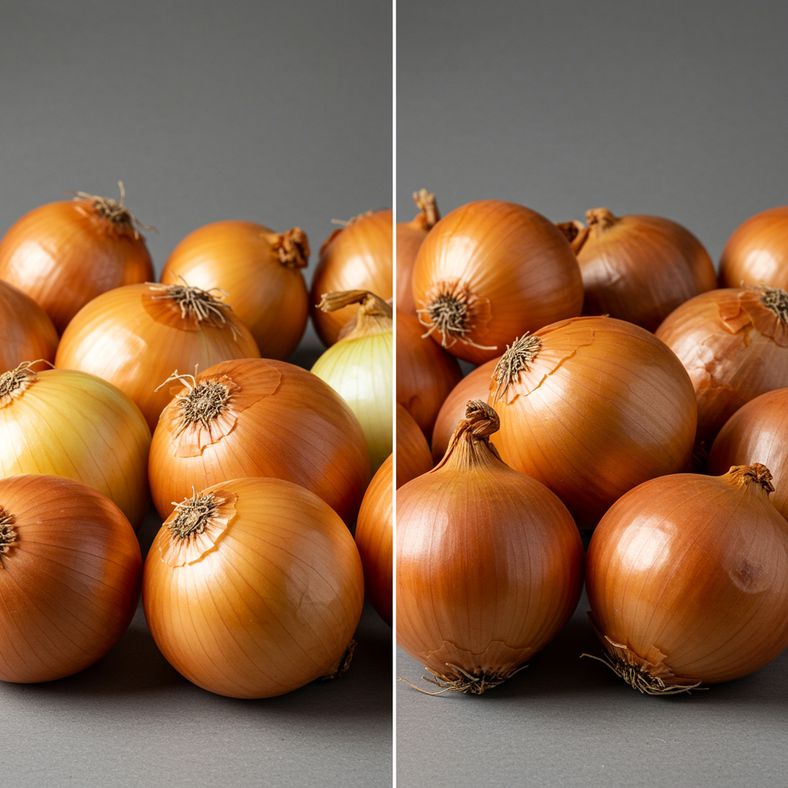
The relationship between final watering timing and storage longevity cannot be overstated. Properly timed cessation of irrigation is fundamental to achieving the dry, well-cured onions that characterise successful long-term storage in UK conditions.
How Water Affects Storage:
- Skin Formation: Dry conditions in the final weeks allow proper development of the protective papery outer layers that prevent moisture loss and pathogen entry during storage.
- Neck Drying: The neck area must dry thoroughly to prevent rot organisms from entering the bulb. Continued watering keeps this vulnerable area moist and susceptible.
- Internal Moisture Content: Bulbs that receive water too close to harvest retain higher internal moisture levels, making them prone to internal rot during storage.
- Dormancy Preparation: Stopping water helps trigger the natural dormancy processes that allow onions to remain stable during storage.
Storage Duration Expectations:
Properly cured onions from correctly timed watering cessation can store:
- Autumn-planted varieties: 4-6 months (until early winter)
- Spring-planted varieties: 6-8 months (until the following spring)
- Long-storage varieties like 'Centurion': Up to 10 months under ideal conditions
Poor timing can reduce these storage periods by 50% or more, with onions developing soft spots, sprouting prematurely, or rotting within weeks of harvest.
Quality Indicators for Well-Timed Harvest:
Onions harvested after properly timed watering cessation will have firm, dry necks, papery outer skins that rustle when handled, and no soft spots or green areas. The outer skin should be tight against the bulb without wrinkled or shrunken appearance.
Managing UK Weather Challenges During the Critical Period

The UK's unpredictable weather patterns present unique challenges when timing the cessation of onion watering. Late summer can bring unexpected heavy rainfall just when your onions need dry conditions, requiring proactive management strategies.
Dealing with Wet Weather:
- Temporary Covers: Use cloches, plastic tunnels, or even large umbrellas to protect maturing onions during heavy downpours. Remove covers during dry periods to maintain air circulation.
- Drainage Improvements: Create shallow drainage channels between onion rows to direct excess water away from bulbs. This is particularly important in heavy clay soils common across much of the UK.
- Mulch Management: Remove any organic mulches around onions once you stop watering to improve air circulation and prevent moisture retention around bulbs.
- Raised Growing: Consider growing onions in raised beds or ridges, which naturally drain better during wet periods.
Regional Weather Considerations:
Scotland and Northern England: Often experience earlier onset of autumn weather. Plan to stop watering by mid-July for spring crops to ensure adequate drying time before cooler, damper conditions arrive.
Wales and Western Regions: Higher rainfall areas may require more aggressive drainage management and earlier watering cessation to compensate for naturally moister conditions.
Southern and Eastern England: Generally drier conditions allow more flexibility in timing, but be prepared for sudden weather changes that can catch crops at vulnerable stages.
Emergency Harvest Considerations:
If prolonged wet weather threatens during the critical pre-harvest period, consider emergency harvest of any onions showing maturity signs. It's better to harvest slightly early and cure indoors than to lose crops to rot.
Post-Watering Care and Pre-Harvest Preparation
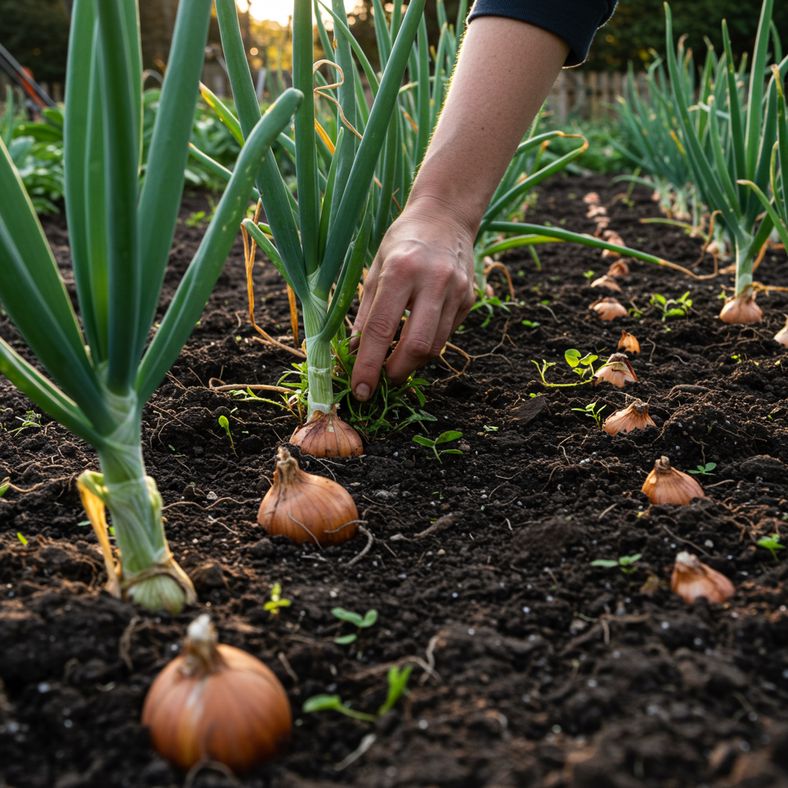
Once you've stopped watering your onions, the final weeks before harvest require specific care to ensure optimal bulb development and storage preparation. This period is crucial for achieving the best possible results from your UK onion crop.
Immediate Post-Watering Actions:
- Weed Control: Remove any weeds that might compete for soil moisture or create humid microclimates around bulbs. Hand weeding is preferable to avoid disturbing developing bulbs.
- Soil Cultivation: Gently cultivate soil around bulbs to improve air circulation and drainage. This also helps expose the tops of bulbs to air and light.
- Mulch Removal: Remove any organic mulches that might retain moisture around bulbs during the critical drying period.
Monitoring During the Waiting Period:
- Daily Inspection: Check onions daily for signs of pest damage, disease, or premature sprouting. Early detection allows for prompt action.
- Foliage Changes: Monitor the progression of foliage yellowing and toppling. This helps you fine-tune harvest timing for optimal results.
- Neck Condition: Regularly check neck areas for softening and drying. This is often the first area to show readiness for harvest.
Preparing for Harvest:
Begin preparing your drying and storage areas during this waiting period. Ensure you have adequate space for the initial 2-3 week drying process that follows harvest. Clean storage containers, check ventilation in storage areas, and prepare any equipment needed for the harvest process.
For larger crops, consider harvesting in stages, starting with the most mature bulbs and leaving others to complete their development. This approach maximises both yield and storage quality across your entire crop.
Variety-Specific Timing Considerations for UK Growers
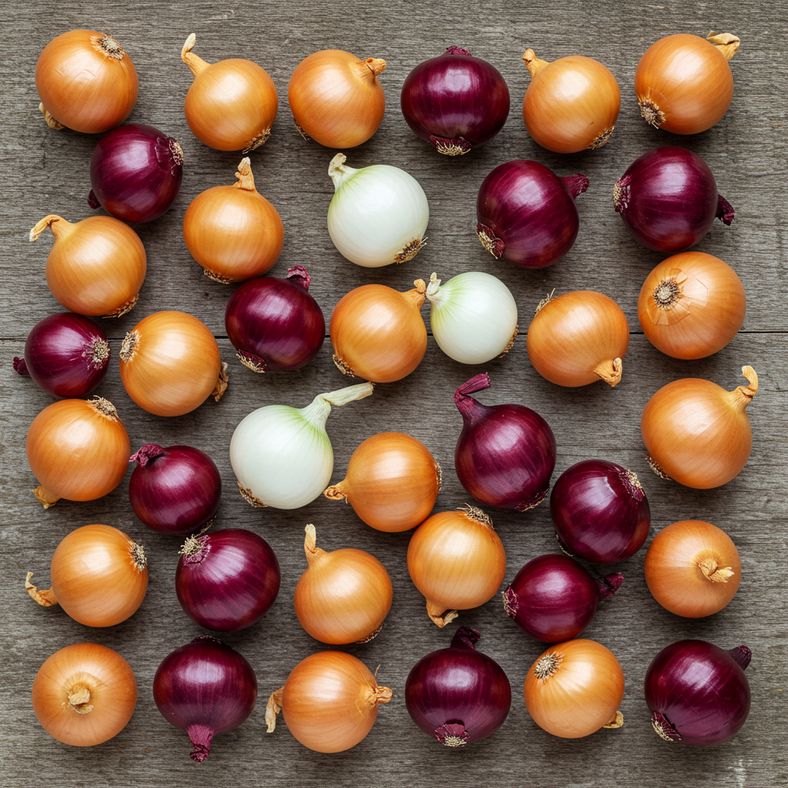
Different onion varieties commonly grown in the UK have varying maturity schedules and water requirements, making variety-specific timing knowledge essential for optimal results.
Early Varieties (June-July Harvest):
- 'Toughball' and other Japanese varieties: Stop watering in late May when foliage begins yellowing. These varieties are bred for early harvest and rapid maturity.
- 'Express Yellow O-X': Cease irrigation by early June. This early variety benefits from prompt cessation to prevent oversizing and storage issues.
Mid-Season Varieties (July-August Harvest):
- 'Centurion' AGM: Stop watering in mid-July. This excellent storage variety requires proper drying time to achieve its renowned keeping qualities. Quality grass seed can help establish good ground preparation for next year's onion beds.
- 'Hercules' AGM: Cease watering in late July. This large-bulb variety needs extended growing time but still requires proper drying preparation.
Late Varieties (August-September Harvest):
- 'Marshalls Red Fen' AGM: Stop watering in early August. Red varieties often require slightly longer drying periods for optimal skin development.
- 'Ailsa Craig': Cease irrigation by mid-August. This exhibition variety benefits from careful timing to achieve maximum size while maintaining storage quality.
Storage Variety Considerations:
Varieties specifically bred for long storage, such as 'Centurion' and 'Stuttgart Giant', are particularly sensitive to watering timing. These cultivars invest heavily in developing protective outer layers and require adequate drying time to achieve their genetic potential for storage longevity.
Bolting-Resistant Varieties:
Modern heat-treated sets and bolting-resistant varieties like 'Hercules' are less likely to flower prematurely, allowing more flexibility in watering schedules. However, they still require proper cessation timing for optimal storage results.
Common Mistakes and How to Avoid Them
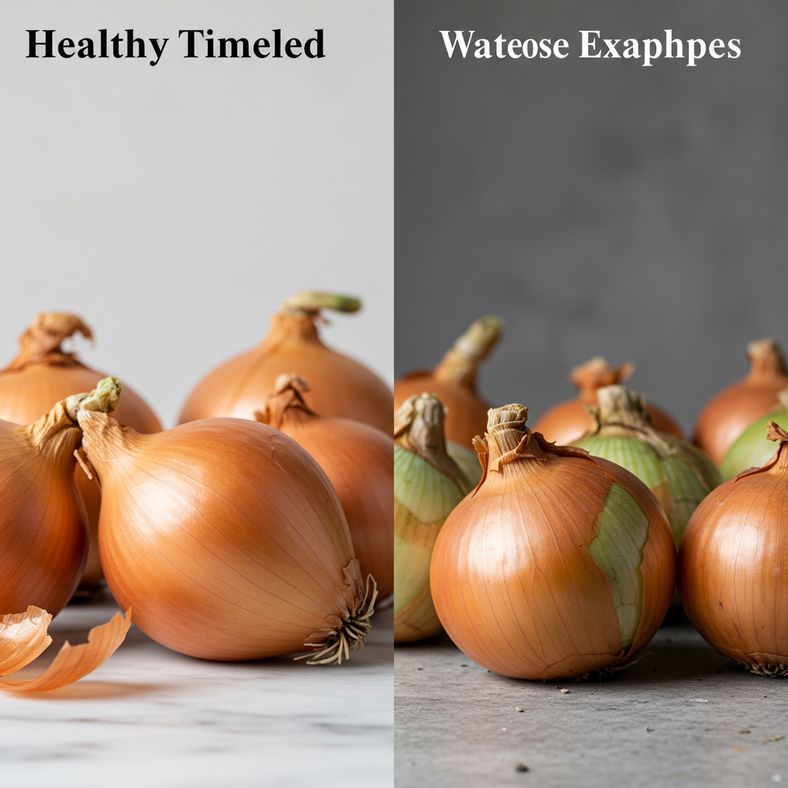
Many UK gardeners make predictable errors when timing the cessation of onion watering, often learned from outdated advice or misunderstanding of modern growing techniques. Avoiding these common pitfalls can dramatically improve your harvest quality and storage success.
The Most Common Mistakes:
- Continuing to Water Too Long: Many gardeners worry about plant stress and continue watering right up to harvest. This is the single most damaging error for storage quality.
- Forcibly Bending Green Foliage: Old-fashioned advice suggests bending over healthy green leaves to force maturity. This damages the plant and reduces storage life significantly.
- Calendar-Only Timing: Relying solely on calendar dates without observing plant signs leads to poor timing decisions, especially in variable UK weather.
- Ignoring Weather Patterns: Failing to adjust timing based on seasonal weather variations can result in waterlogged bulbs or insufficient drying time.
- Harvesting Too Early: Panic-harvesting before proper maturity reduces bulb size and storage potential unnecessarily.
Prevention Strategies:
- Learn Plant Signals: Invest time in understanding natural maturity indicators rather than following rigid schedules.
- Keep Growing Records: Note timing decisions and results each year to build location-specific knowledge for your garden.
- Weather Monitoring: Use weather forecasts to anticipate and prepare for challenging conditions during critical periods.
- Gradual Approach: If uncertain, reduce watering frequency before stopping entirely, allowing plants to adjust gradually.
Recovery from Mistakes:
If you've continued watering too long, immediately cease irrigation and provide extra protection from rain. Consider harvesting earlier than planned if weather threatens, as slightly immature onions store better than waterlogged ones.
For onions that have been force-bent or damaged, harvest these first and use them immediately rather than attempting storage. Mark your records to avoid repeating the mistake in subsequent seasons.
Maximising Storage Life Through Proper Timing
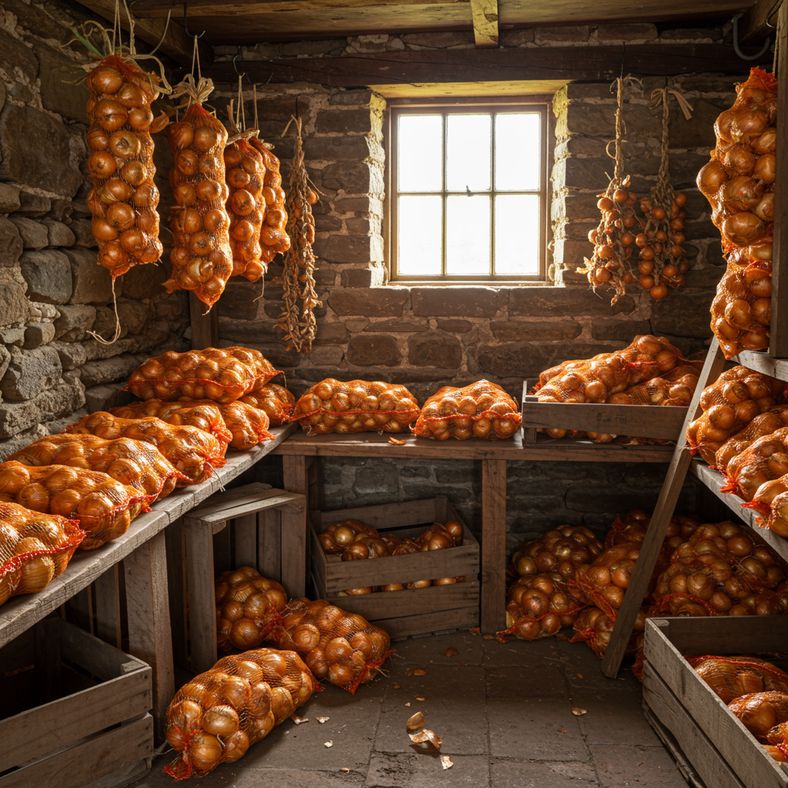
The ultimate goal of proper watering cessation timing is achieving maximum storage life from your onion harvest. UK gardeners who master this timing can enjoy home-grown onions well into the following spring, making the effort invested in precise timing worthwhile.
Optimal Storage Results:
- Properly Timed Onions: Can maintain quality for 6-10 months depending on variety and storage conditions
- Poorly Timed Onions: Often deteriorate within 2-8 weeks, showing soft spots, sprouting, or rot
- Quality Indicators: Well-timed onions have firm necks, papery outer skins, and no signs of moisture retention
Storage Environment Requirements:
Even perfectly timed onions require proper storage conditions to achieve their potential longevity:
- Temperature: Cool but not cold (0-4°C ideal for long-term storage)
- Humidity: Low humidity (60-70% relative humidity)
- Ventilation: Good air circulation to prevent moisture buildup
- Light: Bright conditions prevent sprouting (unlike potatoes, onions should not be stored in darkness)
Monitoring Stored Onions:
Regular inspection every 2-3 weeks allows early detection of problems. Remove any onions showing soft spots, sprouting, or decay immediately to prevent spread to healthy bulbs.
Using Your Stored Harvest:
Use onions in order of storage potential—those with thicker necks or minor imperfections first, saving the perfectly cured specimens for longest storage. This approach maximises the utility of your entire harvest.
For the most demanding cooking applications requiring sharp, crisp onion flavour, properly stored onions actually improve with age for the first few months, developing more complex flavours than freshly harvested bulbs.
Disclaimer: This article contains Amazon affiliate links. We may earn a small commission from qualifying purchases at no additional cost to you.